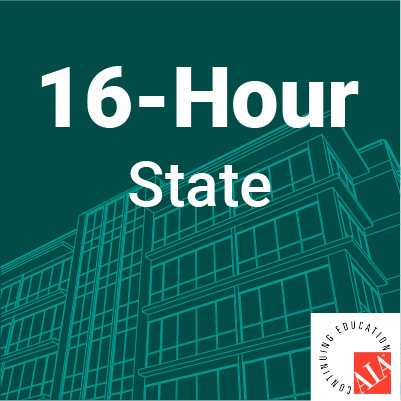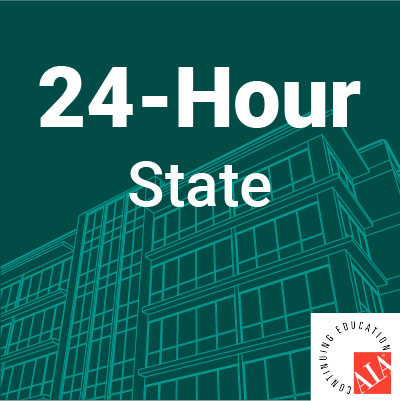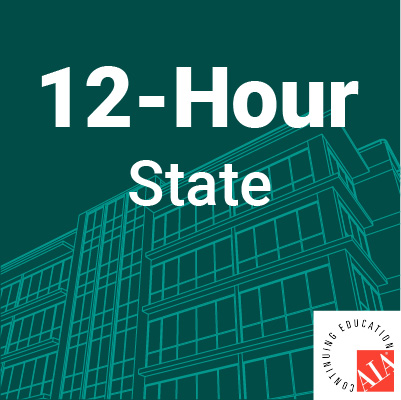Description
Architects 16 Hour Continuing Education Course Package
Meets state continuing education requirements
This 16-hour package contains:
Course #1 – (4 HSW hour Audio Course) Acoustical Design In Modern Architecture | #AIABLTI342.23
Course #2 – (4 HSW hour Audio Course) Designing Worship Facilities | #AIABLTI515.22
Course #3 – (2 HSW hour Audio Course) Speaking of Older Buildings | #AIABLTI517
Course #4 – (2 HSW hour Audio Course) ADA Paths – Part 1 No One Left Behind | #AIABLTI511.23
Course #5 – (2 HSW hour Audio Course) ADA Paths – Part 2 Practical Design Requirements | #AIABLTI512.23
Course #6 – (2 HSW hour Audio Course) ADA Paths – Part 3 Communication and Recreation | #AIABLTI513.23
Credit(s) earned on completion of this course will be reported to AIA CES for AIA members. Certificates of Completion for both AIA members and non-AIA members will be available to print upon completion of this course. This course is registered with AIA CES for continuing professional education.
Acoustical Design In Modern Architecture
Course Instructor: Paul Spite
Unwanted sound impacts and affects inhabitants of our created spaces. If it not already, controlling noise will quickly become a mandated concern for designers. Attesting to increasing regulatory focus on noise, there is a recent proliferation of standards, guidelines, and codes regarding acoustics.
Very soon, many of these guidelines will no longer be mere suggestions. Most concerns covered in these standards can be addressed with a basic understanding on how sound travels and is reflected, blocked, absorbed, or transmitted by materials and assemblies chosen in designing envelopes.
Acoustic design is best addressed in an incremental fashion. This course was written to do just that. Fundamentals are first covered, including basic principles regarding sound, how its energy moves through matter, how its path and intensity can be altered, and how success in the manipulation of sound is measured. Known design strategies are discussed for controlling sound moving; from exterior to interior spaces, from interior spaces to adjacent spaces, within interior spaces, through structural components, and through building systems. Design considerations are outlined for numerous common building functions. Finally, acoustic codes and guidelines in existence now, are listed for consideration.
After completing this course participants will be able to:
- Design objectives and recommended best practices for building types where poor acoustics directly impact productivity and health of the users.
- Determine sources of noise that negatively impact users of built environments, generated both outside and from within buildings, including both air borne and structure borne sounds.
- Outline basic design practices for effectively controlling; sound transfer between exterior and interior spaces, noise transfer from interior space to adjacent spaces, and the reverberation of sound generated within spaces.
- Provide an overview of regulations and guidelines that either are, or may become law underscoring a need for competency in acoustic design, before legislatures make designing for noise control mandatory.
This Course Covers:
- Acoustics in General
- General Vocabulary Regarding Sound and Nature of Sound
- Production, Control, sound transmission and Reception
- Audible Sound Frequencies
- Effects of Sound on People
- Principals of Acoustics
- Sound Behavior Patterns
- Acoustic Measurements
- Amplified Sound
- Design Solutions for Specific Concerns Regardles of Project Type
- Resisting transmission of noise from the exterior into the interior of a space
- Resisting horizontal and vertical transmission of noise from space to adjacent space, including structure borne sound
- Controlling reverberation time of sound generated within a space
- Masking unwanted noise with sound generating systems
- Controlling system sounds, especially HVAC noises, that enter a space
- Design Considerations by Specific Project Type
Designing Worship Facilities
Instructor: Paul Spite
Many decisions need to be made when undertaking the design of a facility to be used for worship. Some are esoteric, dealing with considerations on how to design the structure to best approach God. But others are more mundane, concerned with the fact that before the building may be occupied, the designer must first please men. This course will deal with the second.
Satisfying the needs of people involved in the project will involve those both inside and outside of the client group. Unless societal guidelines, like codes, zoning restrictions and existing easements are honored, regulatory agencies can make sure the building process doesn’t begin. Lending agencies will impose restrictions that must be honored. Site conditions will result in sometimes inflexible conditions on how the land may be used. The needs of the building community that will be translating construction documents into a physical reality must be addressed, as well as the way that process will come to fruition. Finally, every member of the religious group called the client will be bringing their own ideas to the table regarding the desired end result.
This course is designed to look at the many, sometimes seemingly endless parameters and decisions that must be made and addressed, before and during the design of a worship facility.
This course teaches the following specific knowledge and skills.
- A thorough understanding of the types of parameters that must be satisfied in the design of worship facilities
- An increased awareness of the various functions usually needing accommodated in worship facilities
- Knowledge of basic options available to religious groups facing the need to change or expand their facilities to accommodate growth
- How to guide religious groups in acknowledging the many costs besides the building, involved in completing projects, considering sources for capital and determining their financial feasibility of proceeding
- Educating clients regarding various players who will be involved in making their dream a reality and how to go about selecting them
- Different societal guidelines that act as parameters to be met while designing worship facilities
- Master planning considerations that should be incorporated in sites, buildings, systems and furnishings for religious clients
- Basic acoustic considerations to be addressed while designing the primary spaces of buildings used for assembly purposes
- Practical considerations and rules of thumb that help with initial layouts and schematic design of worship facilities
- Typical areas of concern found in building code restrictions, tending to govern the design of worship facilities.
This course covers:
- Introduction
- Options for Growth
- Counting the Costs
- Potential Sources of Capital
- Players in the Process
- Master Planning
- Acoustics in Worship
- Practical Concerns / Rules of Thumb
- Materials and Choices
- Rules and Regulations
- Building Codes Pertinent to Worship Facilities
- Conclusion
Speaking of Older Buildings
Instructor: Paul Spite
When the question of what to do with older buildings arises, it usually resolves itself to choices of reusing them as is, repairing them, restoring them, repurposing them or replacing them.
There is an old saying regarding existing buildings that goes like this. “It has good bones.” Any facility, free of structural defects and doing a reasonably good job of keeping water out, represents a tangible asset. The trick to maximizing the value of existing structures, especially in areas where changing economic factors have also resulted in changing market demands, is to approach their reuse from a different point of view. The judicious employment of renovation funds should not be based on restoring them to a previous use, but making them suitable for other markets in which the existing bones might enable a whole new purpose.
This presentation proposes criteria that may prove valuable in determining which option For the disposition of older buildings represents the best value for the owner, the buyer or the community in which the structure is located. It will also briefly examine a potential business opportunity in a collaboration between architects and commercial real estate agents.
For the benefit of everyone involved, any reuse of older buildings is better than none. Some thought just needs to be put into the options of how to do so, before any decision is made on to the best way to proceed.
By the end of this course, the design professional will be able to:
- Understand the various stakeholders seeking to provide input into the end use of a newly acquired aged structure.
- Readily identify system components needing to be included in the assessment of an older or historic building, as part of determining how to proceed with its further use.
- Be able to explain what determine historic significance and how cultural significance plays a role in the practicality of restoring all or part of a heritage building.
- Realize principles inherent in a decision to move forward with adaptive reuse, both the benefits and the difficulties encountered.
- Develop a solid rationale for why or why not an older building should be demolished and replaced with a more modern structure on the same site.
- Have a grasp of what can be accomplished through a collaboration between architects and commercial realtors, in regards to the reuse of older buildings.
This course covers:
- Assessing Options
- Reuse
- Repair
- Restore
- Repurpose
- Replace
- Realtor/Architect Collaboration
- Summary
ADA Paths – Part 1 No One Left Behind
Instructor: Paul Spite
In September of 2010, the U.S. Department of Justice published the “2010 ADA Standards for Accessible Design,” a comprehensive set of standards about designing buildings to facilitate their use by the handicapped. The publication contained two parts, one establishing accessibility laws for facilities built with public funds, and one providing guidelines for public buildings built by private entities. Since that time, numerous model codes, building codes and published standards have been released, based in part or in whole on those standards, creating some confusion as to what exactly is required. This course is a comprehensive overview of the original guidelines and their intent.
The “2010 ADA Standards for Accessible Design,” though quite lengthy, have been broken out and grouped into nine categories of information, presented in the following sequence. A series introduction discusses the creation of the standards and their applicability as regulations. This course then focuses on the additional parts of the standards addressing; accessible parking facilities and accessible building entryways.
An attempt was made to simplify these regulations and present them in an orderly and comprehensible fashion. Hopefully, the resulting information will be of use in designing public accommodations and commercial facilities, making them readily accessible to, and usable by, individuals with disabilities.
This course teaches the following specific knowledge and skills:
- An understanding of the difference between accessibility laws mandated for buildings constructed using governmental funds, accessibility guidelines for buildings built by private entities for public use, and practical exceptions to both
- Design principles to ensure parking facilities accommodate use by the handicapped
- An overview of the importance of providing accessible routes between parking facilities and building points of entry
- Materials and methods to construct walking surfaces allowing easy passage and use by the handicapped, including stairs and ramps.
- An overview of design principles resulting in making vertical transportation equipment, like lifts and elevators, of better use to the handicapped
- Maneuvering clearances needed at, and between, doors and gates
This Course Covers:
- Compliance Dates
- Scope of Coverage
- Exceptions
- Requirements Pertaining to Specific Building Types
- Additional Exemptions
- Parking Space Requirements
- Location of Parking Facilities
- Physical Characteristics of Parking Facilities
- Accessible Routes
- Entrances
- Doors, Doorways and Gates
- Elevators and Lifts
- Security Barriers
- Accessible Means of Egress
- Accessible Routes
- Stairways
- Case Study
- General Provisions
- Doors, Doorways, and Gates
ADA Paths – Part 2 Practical Design Requirements
Instructor: Paul Spite
In September of 2010, the U.S. Department of Justice published the “2010 ADA Standards for Accessible Design,” a comprehensive set of standards about designing buildings to facilitate their use by the handicapped. Since that time, numerous model codes, building codes and published standards have been released, based in part or in whole on those standards, creating some confusion as to what exactly is required.
This specific course is an overview of some of the accessibility standards governing the design of public structures as they relate to navigating through a building. Topics covered include turning spaces, elevators, assembly areas, medical facilities, lodging, courtrooms, equipment and more.
This course teaches the following specific knowledge and skills:
- Turning spaces required for easy passage of those occupying mobility aids
- Requirements needed to prevent obstructions on, beside and above paths of travel, from preventing passage wheelchair users.
- Signage, signal and call devices needed to facilitate use of elevators and lifts by handicapped occupants of all descriptions
- Requirements for accessibility, maneuvering and clear spaces that are particular to the use of specific spaces normally found in our buildings
- How intermediate height surfaces and fixtures, like counters, benches, lockers, mailboxes, fuel dispensers, etc., should be designed to facilitate use by the disabled
- Height limits and other dimensional data needed to ensure that, plumbing equipment normally used in toilets and bathing facilities remain usable to the handicapped
This Course Covers:
- A Clear Path
- Vertical Conveyances
- Case Study
- Assembly Areas
- Medical Care and Long-Term Care Facility Requirements
- Accessible Transient Lodging Guest Rooms
- Storage Facilities
- Miscellaneous Components
- Accessible Judicial Facilities
- Accessible Residential Facilities
- Accessible Saunas and Steam Rooms
- Accessible Dressing, Fitting, and Locker Rooms
- Patient Rooms in Medical Care and Long-Term Care Facilities
- Accessible Holding and Housing Cells
- Accessible Courtrooms
- Accessible Transportation Facilities – Busses
- Accessible Transportation Facilities – Rail Platforms
- Case Study
- Areas with Plumbing
ADA Paths – Part 3 Communication and Recreation
Instructor: Paul Spite
In September of 2010, the U.S. Department of Justice published the “2010 ADA Standards for Accessible Design,” a comprehensive set of standards about designing buildings to facilitate their use by the handicapped. The publication contained two parts, one establishing accessibility laws for facilities built with public funds, and one providing guidelines for public buildings built by private entities. Since that time, numerous model codes, building codes and published standards have been released, based in part or in whole on those standards, creating some confusion as to what exactly is required. This course is a comprehensive overview of the original guidelines and their intent.
The “2010 ADA Standards for Accessible Design,” though quite lengthy, have been broken out and grouped into nine categories of information, presented in the following sequence. A short series introduction discusses the creation of the standards and their applicability as regulations. This course then focuses on the additional parts of the standards addressing; communication features for the disabled, consideration of finishes to use with mobility aids and recreational facilities to provide continued enjoyment by the handicapped.
An attempt was made to simplify these regulations and present them in an orderly and comprehensible fashion. Hopefully, the resulting information will be of use in designing public accommodations and commercial facilities, making them readily accessible to, and usable by, individuals with disabilities.
This course teaches the following specific knowledge and skills:
- Features and functions of alarm and notification systems in facilities designed to be accessible and usable by disabled occupants of all descriptions.
- Characteristics and defining features of visual, Braille, pictograms and tactile characters, ensuring that signage in accessible locations is legible to, and usable for, all occupants
- Consideration of flooring surfaces and finishes, including allowable changes in level, to ensure smooth passage over them
- Features of various facilities designed for recreation, so as to make continued enjoyment possible for the disabled.
This Course Covers:
- Communication Features in General
- Notifications
- Signage
- Accessible Telephones
- Transportation Facilities
- Assistive Listening Systems
- Accessible Automatic Teller and Fare Machines
- Accessible Two-Way Communication Systems
- Surfacing Materials
- Furniture
- Recreational Opportunities
- Accessible Amusement Rides
- Accessible Recreational Boating Facilities
- Accessible Fishing Piers and Platforms
- Accessible Exercise Machines and Equipment
- Accessible Golf Facilities
- Accessible Miniature Golf Facilities
- Play Areas
- Accessible Swimming Pools, Wading Pools, and Spas
- Accessible Shooting Facilities with Firing Positions
Credit(s) earned on completion of this course will be reported to AIA CES for AIA members. Certificates of Completion for both AIA members and non-AIA members are available to print upon completion of the course.


